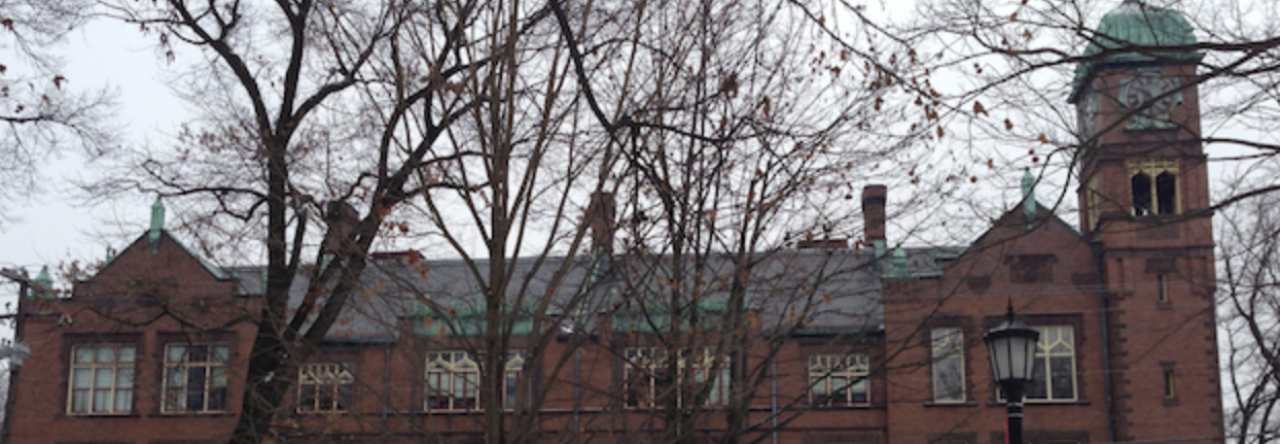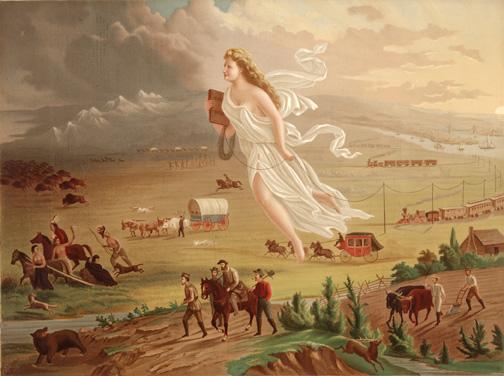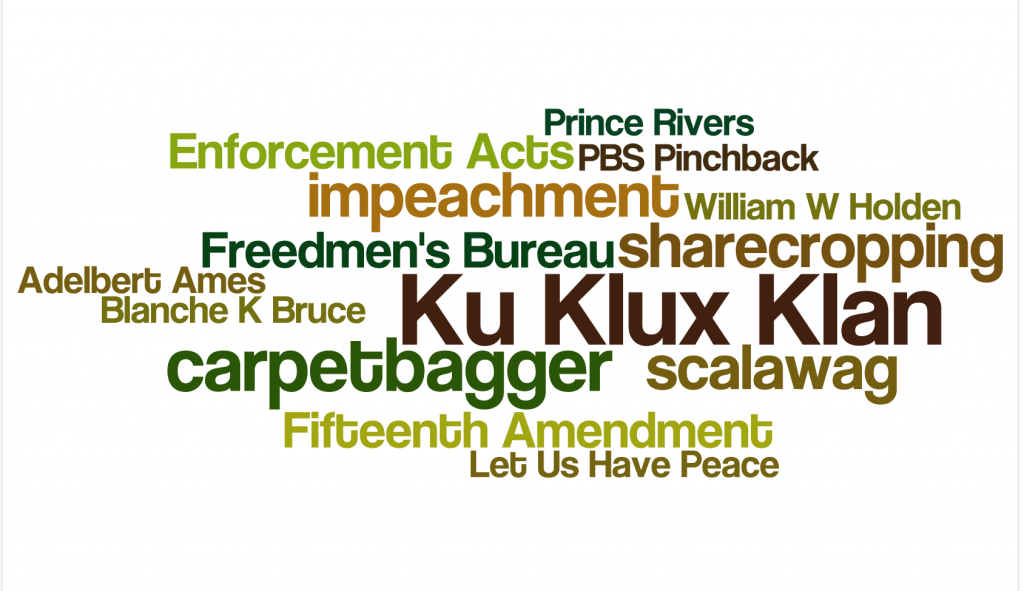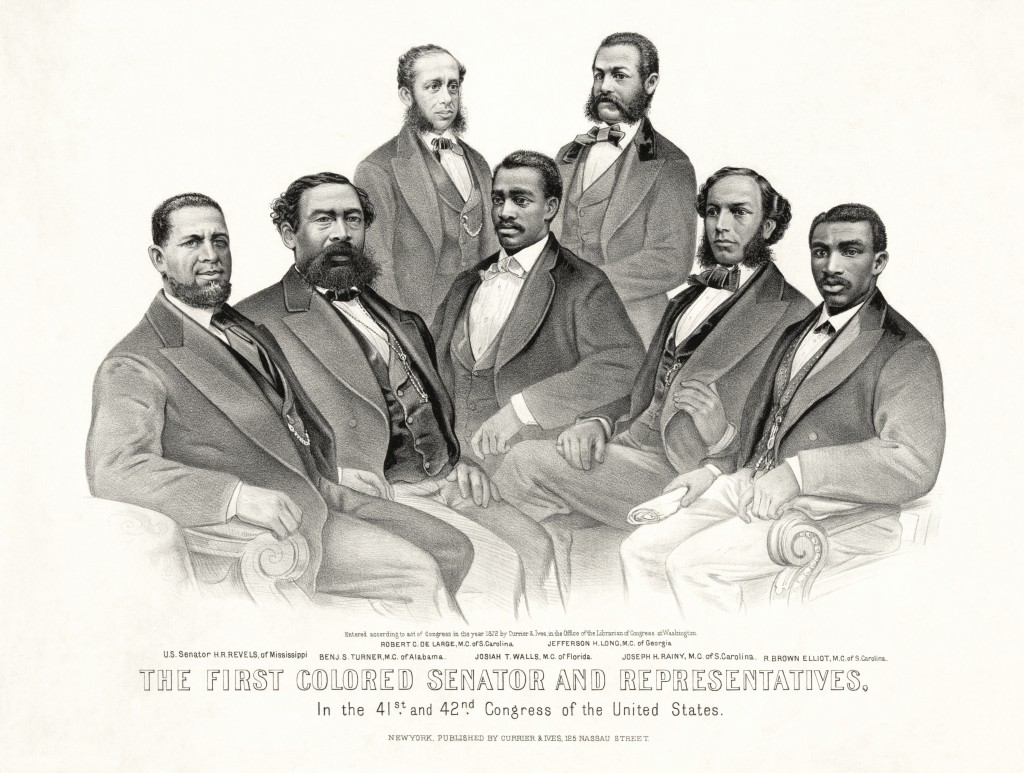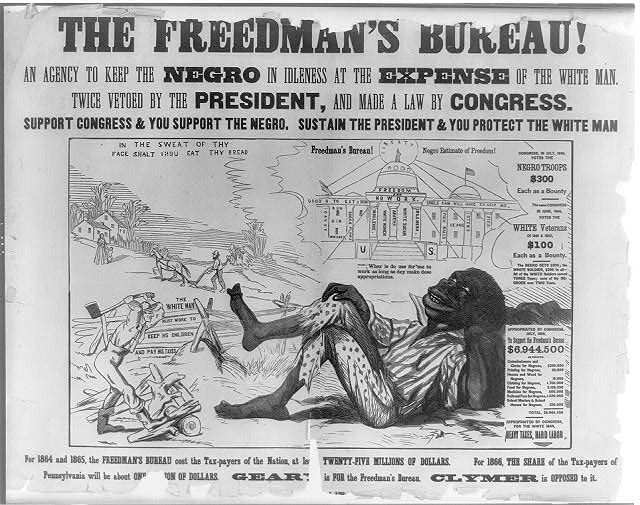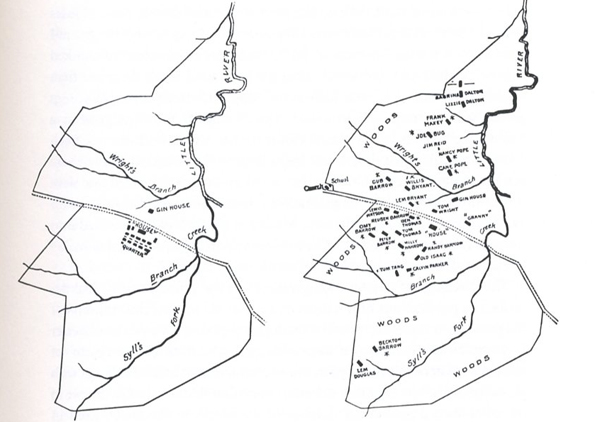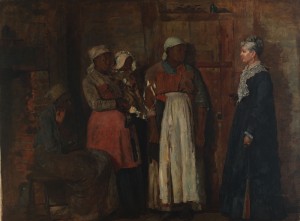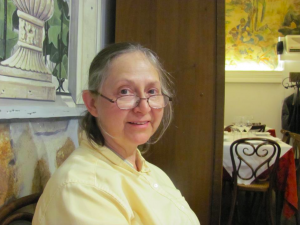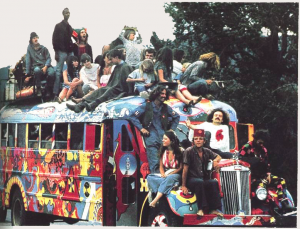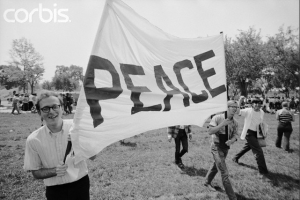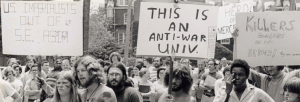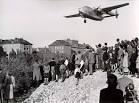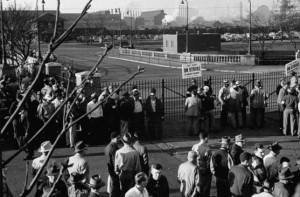Southerners were not the only Americans whose lives were transformed during the decades immediately following the Civil War. Northerners did not face the same challenges of political reconstruction or economic transition in the aftermath of slavery, but they did face a series of revolutionary experiences. Students in History 118 should be able to identify the main social, political and economic forces that ripped apart the North during the 1870s and 1880s, but they should also be able to explain the story of westward expansion in great depth. That was a story of unexpected complexity, one that can be at least partially summarized through a close reading of this famous painting by John Gast, entitled, “American Progress,” (1872).
Political life in the South during Reconstruction kept changing at a rapid pace. In his book, A Short History of Reconstruction, Eric Foner charts a remarkably complicated set of factors that elevated some groups over others at different times across various states during the period between 1865 and 1877. Once Congress wrested control of the political restoration process away from President Johnson in 1866 and 1867, the result was a brief revolutionary heyday for black political leadership. Yet there was always violent resistance lurking in southern communities determined to stop participation in government by the ex-slaves. The fight culminated with the battle to enforce the Fifteenth Amendment and suppress the rise of the Ku Klux Klan across the South. This was a challenge that even a more conservative figures in the Republican Party seemed to embrace –at least at first. President Grant led the fight to crush Klan-inspired political violence –a determination that surprised some contemporaries who had voted for Grant under the slogan, “Let Us Have Peace.” Yet, even though the post-war Klan was crushed by federal action in the early 1870s, the extent of white support for black politics seemed to collapse as the 1870s drew to a close. Consider some of the following images and see if you can explain any or all of them t can be used to help illustrate important points about American political and economic life in the South during the 1870s.
Word Cloud inspired by Foner’s Short History
Black Senators and Congressmen, circa 1872
Anti-Freedmen’s Bureau political cartoon (1866):
Map of the Barrow Plantation, during and after slavery:
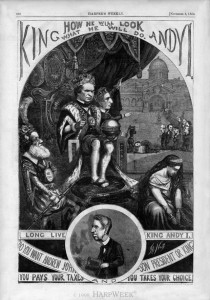 American politics has always been pretty rough, but perhaps no period was as bare-knuckled and partisan as the Reconstruction era. The confrontations involved more than just political combat between Democrats and Republicans. There were factions at odds with factions. Most notably, President Andrew Johnson waged war against Radical Republicans. These men had once been Unionist allies, but now found themselves in bitter disagreement over Reconstruction policy in the South. The result of this escalating conflict was the impeachment crisis of 1868. Thomas Nast, a leading cartoonist for Harpers Weekly depicted this crisis in a brilliant series of cartoons for the magazine. Please browse the selection of these cartoons and select one that seems to embody some of the most important insights from Eric Foner’s history of the period.
American politics has always been pretty rough, but perhaps no period was as bare-knuckled and partisan as the Reconstruction era. The confrontations involved more than just political combat between Democrats and Republicans. There were factions at odds with factions. Most notably, President Andrew Johnson waged war against Radical Republicans. These men had once been Unionist allies, but now found themselves in bitter disagreement over Reconstruction policy in the South. The result of this escalating conflict was the impeachment crisis of 1868. Thomas Nast, a leading cartoonist for Harpers Weekly depicted this crisis in a brilliant series of cartoons for the magazine. Please browse the selection of these cartoons and select one that seems to embody some of the most important insights from Eric Foner’s history of the period.
Eric Foner and Olivia Mahoney have created a web-based exhibition hosted by the University of Houston that is designed to accompany his published work on Reconstruction. Students in History 118 should browse the image gallery of the sections of the exhibit entitled “Meaning of Freedom” and “From Slave Labor to Free Labor” in order to immerse themselves in the images and stories of the formerly enslaved people fighting to establish themselves as free American citizens. These types of visual exhibitions sometimes are even more effective than print sources in conveying the experiences of ordinary people in the past. What does this exhibit reveal about the everyday life of Reconstruction for the freed people?
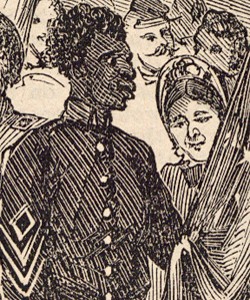
Prince Rivers (1822-1887)
The story of Prince Rivers embodies many of the insights which Eric Foner tries to convey in the opening chapters of his book, A Short History of Reconstruction (2015 ed.). Rivers was a “contraband,” a wartime runaway slave, who fled behind Union lines along the South Carolina coast in 1862. He joined the Union army, serving in one of the first all-black regiments, and became something of a wartime celebrity. Later, during post-war Reconstruction, he became a political figure in South Carolina. The sad ending to his career, however, suggests how, as Foner put it, Reconstruction truly became, “America’s Unfinished Revolution.” You can read about Rivers in the following two posts at the Emancipation Digital Classroom. Try to use his story to punctuate Foner’s analysis about “Wartime Reconstruction” and the various “Rehearsals for Reconstruction.”
The end of the Civil War brought about the restoration of the Union and the end of slavery, but were these two objectives really one and the same? If so, does Abraham Lincoln deserve the lion’s share of the credit for melding them together? These are the types of questions that historians argue over. So did nineteenth-century Americans. One way to engage a fresh perspective on that debate is to examine what a commercial printer in Philadelphia did with a popular image following Abraham Lincoln’s assassination in 1865. Here is what the image looked like that year:
Yet here is what the original illustration looked like in January 1863 when Thomas Nast first drew it for Harpers Weekly:
 The difference is more than just color. Nast’s allegory for emancipation has now been subtly altered to give the martyred president a greater role.
The difference is more than just color. Nast’s allegory for emancipation has now been subtly altered to give the martyred president a greater role.
Below is a photograph taken at Fort Sumter on Friday, April 14, 1865. That was a special day for the Union coalition –a kind of “mission accomplished” moment as Col. Robert Anderson returned with a delegation of notables, including abolitionists like Rev. Henry Ward Beecher and William Lloyd Garrison, to raise the American flag once again over the fort in Charleston harbor where the Civil War had begun almost exactly four years earlier.
 Note the cracked glass plate from this seemingly ruined photograph now in the collection of the Library of Congress. But look what happens to this image when it is digitized at a high resolution and then magnified.
Note the cracked glass plate from this seemingly ruined photograph now in the collection of the Library of Congress. But look what happens to this image when it is digitized at a high resolution and then magnified.
That’s Rev. Henry Ward Beecher speaking on the afternoon of Friday, April 14, 1865, from what he called “this pulpit of broken stone.” Originally, scholars, using magnifying glasses, thought that William Lloyd Garrison was perhaps seated on Beecher’s left.
 But now we are confident at the House Divided Project that Garrison was actually seated in a special section on Beecher’s right, with other leading abolitionists and Lincoln administration notables.
But now we are confident at the House Divided Project that Garrison was actually seated in a special section on Beecher’s right, with other leading abolitionists and Lincoln administration notables.
It was obviously a moving, reflective moment for Garrison, one captured in this detail image above from right after the ceremony and by the little known story of his visit the following morning to see the grave of secessionist icon John C. Calhoun. You can read more about this episode here and here. Sometimes people are surprised by the stories that slip out of public memory and don’t make it into standard textbooks. The Garrison visit to South Carolina in April 1865 is certainly one of them, but another such lost tale involves a Dickinsonian named John A.J. Creswell, who was deeply involved in the final passage of the Thirteenth Amendment to abolish slavery, which occurred in early January 1865. Here is the image that appeared in Frank Leslie’s Illustrated Newspaper to celebrate that moment.
You will notice the trio of men in the lower right hand corner, obviously prominent figures according to the illustrator. We researched them here at the college and were thrilled to discover that one of them was a Dickinsonian. It turns out that these are three congressman from the Mid-Atlantic (from left to right) Thaddeus Stevens, William D. Kelley, and John A.J. Creswell. We used a detail from that image for the cover of our first House Divided e-book, which profiles Creswell, a Dickinson graduate and Maryland politician who became one of the nation’s most important wartime abolitionists. Yet, he’s almost completely forgotten, not even mentioned in Steven Spielberg’s movie “Lincoln” (2012), which concerned passage of the amendment. You can download a free copy of Creswell’s biography, written by Dickinson college emeritus history professor John Osborne and college librarian Christine Bombaro, here. Ultimately, that might be the best way to rediscover the drama at the end of the Civil War –by seeing old stories from new perspectives.
By Matt Pasquali
Patricia Mackey was a college student at the State University of New York at Plattsburgh during the Kent State shootings, occurring on May 4, 1970. According to H.W. Brands book, American Dreams, on “hundreds of campuses across the country students boycotted classes and faculty suspended teaching in favor of discussions—which was to say, condemnation—of the war.” [1] Mackey remembers the immense cultural changes that took place on her campus after the shootings. “It was as though all hell had broken loose,” Mackey recalled about the day of the tragedy, “suddenly sleepy Plattsburgh campus became a hotbed of student unrest.” [2] Although Mackey’s experiences were common throughout American colleges and universities, her recollections during this time of turmoil are important because such memories can help show the drastic changes seen throughout American culture. However, memories from 40 years ago can become twisted over time. Ultimately, there were significant cultural changes seen post Kent State that Mackey lived through, keeping in mind that not everything was changed because of this event.
One of the most immediate changes seen during this era was among the nation’s youth. “People learned to question everything” after the shootings at Kent State. [3] “Students who had been quiet, reserved in their actions…lost the majority of their social inhibitions,” Mackey remembers. Changes in music, TV and the newly acquired drug culture became a “stronger force for expressing the public’s dissatisfaction with the status quo.” [4] The newly acquired drug culture affected everyone even if they didn’t partake in such activities. “You might not actually use marijuana or PCP…but they affected you,” recalled Mackey. Mackey noted how the drug culture caused people to “discard the traditional suit or dress of the past” and trade it in for a “psychedelic tie-dye T-shirt, bell bottom pants and sandals of the era.” She also claimed to witness her roommate “passed out in the dorm’s elevator,” an “over-drugged” student leap out of his dorm room on the sixth floor, and she claimed that the new trend of smoking marijuana caused her clothes to “smell of marijuana” regardless of if she participated in the usage or not. [5] Drug culture was everywhere and it started having effects on the entertainment business. “By way of TV at Woodstock” and “through the anti-war songs,” civilians started turning into hippies, who demonstrated their disapproval of the current wartime and aftermath of the Kent State shootings through this new type of music [6] Such rapid changes even affected athletics, where the largest impact was seen through “postponement of practices and contests.” [7]
The ongoing effects of the Kent State shootings and the Vietnam War left an impact on civil rights issues pertaining to women and blacks. “Widespread protests and the televising of the process became the norm,” Mackey noted. “Those who protested the war combined their efforts with those who protested in favor of increased rights for Blacks and women,” Mackey added. Campuses, such as Mackey’s, turned into “chaos” while students became “crazily radicalized over night.” [8] However, such chaos helped campuses across the United States become less strict about the rules regarding female students. “Young women no longer had to stay in separate dorms; they could live in co-ed dorms and use co-ed bathrooms.” [9] Mackey also notes how “no one kept track of their schedules or their whereabouts any longer” and “there was no longer a curfew for girls.” With fewer restrictions on females, there was an increased opportunity created for women after more and more people began protesting for what they believed in. As for blacks, changes were seen during the Vietnam War era, but were not as substantial as the progression seen in the movement for women’s rights. The first war blacks were allowed to enter the army was World War II, and by Vietnam times, “Blacks were drafted in higher proportional numbers than whites” but “were often required to do the most dangerous work.” [10] Blacks got what they wanted but were treated poorly. “Blacks also could not serve as officers,” Mackey adds. Even though “Blacks gained rights, at least in terms of the law” they were still treated with unequal and unfair opportunities in American society. [11]
Education was another visible cultural change seen throughout this era. One of the most immediate changes seen on Mackey’s campus after the shootings was that “no one went to class” and students attended “teach-ins” to learn about the United States’ involvement in the Vietnam War. SUNY Plattsburgh President George Angeil even allowed students to use “his office for strike-coordinating activities.” [12] Nationwide, “detrimental” effects were seen on 18% of college campuses, according to historians Richard Peterson and John Bilorusky, and “academic standards could be said to have declined or academic integrity to have been comprised” after the Kent State debacle. [13] Classes at SUNY Plattsburgh “were officially cancelled” and students were given the option to “take the grade [they] had when everything had fallen apart” or contact their professors to discuss their grades. [14] This was a nationwide effect and Peterson and Bilorusky note that in as many as one in four colleges, classes were brought to an abrupt end. [15] In the following semester, drastic changes in course content changed, as well as policies regarding dropping courses. Mackey explained how you could now “drop/change courses without a penalty” and questioning the professor “about the grade you received” was now common. [16] She also explained how by her recollection, courses “suddenly changed.” Courses started incorporating content regarding “Africa and Asia, current events, civil rights” and the “women’s liberation movement.” Courses also started incorporating “Chinese and Indian classics, world religions…and courses on what other cultures are like and…what they thought of America.” [17] Schools, such as Mackey’s, “began to study and analyze the cultures of Africa and Asia because our ignorance of such things in Vietnam.” [18]
Antiwar movements and strikes swept the nation after the Kent State shootings and the ongoing war in Vietnam. Peterson and Bilorusky state that “significant impact” was portrayed at 57 percent of American colleges after the Kent State shootings. [19] Peterson and Bilorusky also report “essentially peaceful demonstrations” on 44 percent of the American colleges. [20] Such demonstrations included “sit-ins, parades, picketing, mass meetings, rallies…and so forth.” [21] However, these peaceful protests led to threats of violence at schools such as Mackey’s. “There was a sense of urgency—a feeling that we had to get involved,” explained Mackey. “Someone came up with the idea of a march on the Air Fore Base…they were met at the gate of the base by servicemen with loaded guns who told them in no uncertain terms that if they came closer, they would be shot.” [22] The amount of student participation in antiwar movements “had exactly doubled” from January 1970 to June 1970. [23] There was such a high demand for locations to hold protest meetings that “universities bent over backwards to provide students with office space.” [24] Antiwar movements and strikes became more and more common.
During times as vulnerable as they were in the late 1960s and early 1970s, it only takes one dramatic event to spark change. The Kent State shootings created “a new wave of arson” and can be looked upon as a pivotal turning point in American culture. [25] Changes in all aspects of culture were seen: education, women’s rights, black rights, and the increased participation in antiwar movements and protests. Without the unfortunate event at Kent State University on May 4, 1970, we may not have seen such important changes in American culture.
[1] H.W. Brands, American Dreams: The United States Since 1945 (New York: Penguin Books, 2010), 170.
[2] Email interview with Patricia Mackey, March 20, 2015.
[3] [Mackey] interview.
[4] [Mackey] interview.
[5] [Mackey] interview.
[6] [Mackey] interview.
[7] Husar, John. “Big 10 Coaches Feel Effect of Campus Riots.” Chicago Tribune. 18 May 1970: c2. [Historical Newspapers].
[8] [Mackey] interview.
[9] [Mackey] interview.
[10] [Mackey] interview.
[11] [Mackey] interview.
[12] Linda Charlton, “Activity Stepped Up Here: Students Move Off Campus to Widen Protest Here,” New York Times, May 7, 1970 [ProQuest].
[13] Peterson, Richard E., and John A. Bilorusky. May 1970: The Campus Aftermath of Cambodia and Kent State. (Berkeley: Carnegie Foundation for the Advancement of Teaching, 1971), 25.
[14] [Mackey] interview.
[15] Peterson and Bilorusky. 16.
[16] [Mackey] interview.
[17] [Mackey] interview.
[18] [Mackey] interview.
[19] Peterson and Bilorusky. 15.
[20] Peterson and Bilorusky. 15.
[21] Peterson and Bilorusky. 15.
[22] [Mackey] interview.
[23] Beggs, Daniel C., and Henry A. Copeland. “Opinion on the Campus: Students Become More Willing to Support Beliefs with Action.” Chicago Tribune. 01 August 1970: w2. [Historical Newspaper].
[24] Oliphant, Thomas. “Universities Feel Compelled to Restrict Anti-War Activities on Campus.” Boston Globe. 19 July 1970: 1. [Historical Newspapers].
[25] Brands. 170.
By: Jordan Forry
H.W. Brands devotes three chapters of his book, American Dreams, to the early Cold War era. As the primary purpose of his book appears to be to provide an overview of modern American history in narrative form, most of these chapters focus on big picture trends. Brands does an excellent job of conveying the major events that occurred in that time period and the formal policies set out by the government. However, this big picture approach leads to many generalizations, especially regarding the home front. In this essay, I will use information gained from an interview with a woman who lived through the early Cold War (Lois Shaffer), as well as, other primary and secondary sources to both confirm Brands’ observations regarding the home front and also elaborate on parts of Brands’ story which may have been over-generalized.
Brands spends a decent amount of space describing the Berlin blockade by the Soviets and the corresponding airlift conducted by the U.S. in 1948-1949. He describes Truman as being determined to “not be pushed out of Berlin by Soviet pressure” and points out the incredible logistics required to coordinate “Hundreds of American and British cargo planes… landing and taking off as frequently as once per minute.” [1] What is lacking in this analysis of arguably the first major showdown between the U.S.S.R. and the U.S. is the attitudes of Americans on the home front. Lois Shaffer recalls that after following the situation on the radio, she and her husband became impressed with the feat that the U.S. military was able to accomplish, but she was also quick to point out that they did not necessarily follow the progress of the airlift on a day to day basis. [2] Part of the support for the airlifts on the home front undoubtedly came from national pride for what the U.S. could accomplish, but it did help that the U.S. military proclaimed its military prowess openly in the news. One example of this includes a Boston Daily Globe article from 1948 in which The Globe reported on the Air Force’s claim that it had the capacity to continue the airlift operation for as long as public support existed for the program. [3] With guarantees from the military that the U.S. could continue indefinitely with the airlifts, Americans had every reason to be optimistic with and support the airlifts under Truman’s leadership.
Brands also describes the Korean War within a policy-oriented framework that leaves out much of the story from the perspective of the home front. He describes the aggression of North Korea against South Korea as follows: “Communism was on the march and the forces of freedom needed to stop it. Korea was a test; if the United States and its allies exhibited resolve, the fighting might go no farther.” [4] Brands does get around to stating that the war, “grew unpopular,” but fails to further elaborate on the complexities of public opinion. [5] Shaffer, whose brother Lester Degroft fought in Korea, expressed conflicting opinions of the war. On one hand, she recalled that the war almost seemed like a continuation of WWII, being that the country had been at peace for only a few years between the wars. On the other hand, she claims that she and other Americans understood the significance of the war and supported Truman. [6] Others, such as Pierpooli Jr. better delineate the stages of American support and rejection of the war effort. Pierpooli claims that in the early stages of the war, Americans largely supported the war effort, but after intervention by communist China in November of 1950, widespread fear and defeatism crept in. [7] The public further lost confidence in the war effort after President Truman’s attempt to seize the striking steel mills ended in public embarrassment with a Supreme Court repudiation of his actions. [8] In sum, Pierpooli concludes that the Korean War “reflected a house divided. It engendered bitter rhetoric… (and) fostered a poisonous atmosphere of paranoia and fear…”[9] These conflicting stories of initial public support for the War and then partial to total rejection of the effort are lost in Brands’ broad overview of the War.
Another important aspect of life on the home front during the early Cold War was the constant threat and psychological toll of a nuclear attack. Brands suggests that Americans were comforted by the slight, but apparent, military advantage the U.S. held in the early years of the Cold War, but “the reassurance could be no more than fleeting, for the nuclear arms race continued, and the shadow across the American future-and the future of the world-grew ever longer.”[10] This quote from Brands suggests three things: that Americans were in grave danger of nuclear attack, that they accurately sensed this danger, and that they felt fear in response to these facts. However, fear may not have been as prevalent as suggested. Russell Baker recalls that just days after the first atomic bombs exploded over Nagasaki and Hiroshima, he and his mother had exchanged letters in which neither of them “indicated that we even realized anything very extraordinary had happened.” [11] Shaffer recalls that the threat of an atomic attack was always on the back of her mind, but it was not something that consumed her on a day-to-day basis or caused her to lose sleep at night. Rather, it represented a dinner conversation piece depending on the news that night. [12] This general nonchalance is reflected by the fact that polls during this period only showed a little more than half of all Americans (53%) thought there was a good or fair chance that their hometowns would be attacked. [13] This means that half of all Americans believed they faced only slim odds of experiencing a nuclear disaster, which seems to be a far less dire situation than which Brands paints. Perhaps individuals instead, as Elaine May hypothesizes, put their efforts into building a family, instead of fearing for the future, as the “home represented a source of meaning and security in a world run amok.” [14]
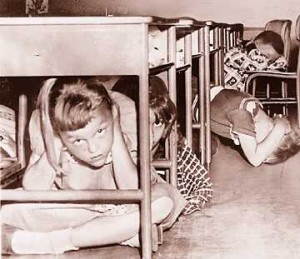
Students demonstrating “Duck and Cover” Circa 1950. Photo Credit: http://undergroundbombshelter.com/news/w….
On the other hand, Americans did have things to fear and did take actions and altered their lifestyles in significant ways to combat the threat of a nuclear attack. For example, Shaffer remembers schools started to have bomb drills and the government encouraged citizens to consider building bomb shelters, even as she and her neighbors did not build them for lack of money.[15] The bomb drills Shaffer recalls are most likely the “Duck and Cover” program that the U.S. government started running in schools that instructed kids to seek shelter under desks, chairs, or against walls whenever they heard an explosion or saw the flash of the bomb. [16] Also, while Shaffer never built a bomb shelter for her family, some cities, such as New York, petitioned the federal government for money to construct such facilities. In 1950, the City Planning Commissioners from New York City determined the cost of building bomb shelters for New York City would total $450,000,000, and that this project represented something “that is practical, can be completed within a reasonable time, and that is needed in view of the world situation.” [17] Finally, in addition to bomb shelters, some individuals also took steps to ensure that they and their families would be ready to survive a nuclear disaster after the initial blast. This would require having enough food stocked to last through the apocalypse. As more and more people sought to prepare themselves for the worst, guides, such as “Grandma’s Pantry to Nuclear Survival,” arose that provided recommendations for how much water, food, and other essentials to have on hand.[18]
In conclusion, life on the home front during the early Cold War was complicated. One of the drawbacks of writing a seventy year narrative of U.S. history like Brands does is it forces one to focus on the overarching themes and policies in American history and can cause one to overlook the complexities of certain times or the effects of certain historical events on the lives of ordinary Americans. By exploring other primary sources from the time, by interviewing a historical witness of the period, and by analyzing other secondary sources, a more complex picture of the U.S. home front during the early Cold War develops; one in which people are allowed to have differences in opinion and experiences. Through this analysis, it becomes evident that although the Cold War weighed heavily on everyone’s minds, it did not completely consume the day-to-day lives of all Americans. In these ways, life on the home front was more complicated than Brands is able to convey in American Dreams.
Footnotes:
1. H. W. Brands, The United States Since 1945: American Dreams (New York: Penguin Books, 2010), 40-41.
2. Interview with Lois Shaffer, Spring Grove, PA, March 12, 2015. (Interview was conducted face-to-face, but not recorded. As such, all material used in the paper is a close approximation of responses given unless quotations are provided).
3. Carlyle Holt, “Lemay Declares U.S. can Maintain Berlin Airlift as Long as Necessary,”Daily Boston Globe, September 14, 1948 (Pro-Quest).
4. Brands, American Dreams, 56.
5. Ibid., 58.
6. Interview with Lois Shaffer, March 12, 2015.
7. Paul G. Pierpaoli, Jr., “Truman’s Other War: The Battle for the American Home Front, 1950-1953,” OAH Magazine of History 14, no. 3 (2000):16-17 (JSTOR).
8. Ibid., 18.
9. Ibid., 19.
10. Brands, American Dreams, 67.
11. Russell Baker, Growing Up (New York: Penguin Books, 1982), 292.
12. Interview with Lois Shaffer, March 12, 2015.
13. Elaine Tyler May, Homeward Bound: American Families in the Cold War Era (New York: Basic Books, 2008), 25 (eBook).
14. Ibid., 26-27.
15. Interview with Lois Shaffer, March 12, 2015.
16. “Duck and Cover,” U.S. Federal Civil Defense Administration Video,9:15 (1951), posted by Archer Productions Incorporated, 2004. https://archive.org/details/DuckandC1951.
17. “Atomic Bomb Shelters?,” The New York Times, August 7, 1950 (Pro-Quest).
18. May, Homeward Bound, 100-101.
By Caly McCarthy
2020 Preface Written By Author
Recently, I was on Facebook and saw a post from the Dickinson History Department regarding the Pinsker Student Hall of Fame. I followed the link and was tickled to see my oral history from 2015 there. However, as I was re-reading it, to be honest, I was cringing at how I framed things.
When I wrote this narrative five years ago I thought that it was a fine piece of oral history, but I no longer hold this position. I failed to acknowledge even once that “riot” is a loaded term that frequently gets employed along racial lines. I should not have used the phrase “young blacks.” I should have contextualized my dad’s comment about “smoldering resentment” to emphasize the inequality that Black people face living amid racist systems. I should not have leaned on a superficial understanding of MLK’s commitment to nonviolence to decry the looting and arson that followed his assassination. I should have questioned the use of the National Guard and martial law in DC.
I thought I was being neutral. I thought that I was simply portraying my dad’s experience. Instead, I unwittingly dismissed the chronic reality of racism in our country by centering this moment in history on property damage and white fear. I offer this preface as an invitation to accountability. Because the way we frame stories about race, violence, fear, and property damage have very real implications for whether we amplify or delegitimize Black lives, cries, and calls for change.
Original 2015 Oral History
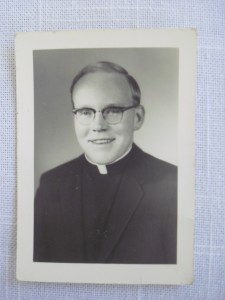
Photograph of Father Joe in 1969, one year after McCarthy was ordained a deacon.
On the day that James Earl Ray assassinated esteemed civil rights leader, Martin Luther King Jr., Joseph McCarthy was ordained a sub-deacon of the Catholic Church in Washington, D.C.[1] Historian H.W. Brands argues that word of Martin Luther King Jr.’s assassination “flashed across the continent and triggered the largest wave of riots to date.”[2] Though cities throughout the nation erupted into riots, civil unrest in Washington, D.C. was especially strong. McCarthy remembers climbing on the rooftop of Catholic University, surveying the city, and observing that “[w]hole blocks were on fire.”[3] McCarthy’s recollections of the riots in Washington, D.C. illustrate the fear and confusion of the time immediately following MLK’s assassination. His recollections of this single uprising offer a vivid account of the race riots that dominated America in the late 1960s.
In preparation for his ordination, McCarthy had attended Montford Prep, a boarding school in New York state. He later attended St. Mary’s College in Kentucky for his undergraduate degree, where he majored in philosophy and minored in classical languages. After graduation he continued study at Kenrick Seminary of St. Louis, Missouri, and Catholic University of Washington, D.C.. On April 4, 1968, McCarthy was just shy of 28 years old. He had lived in Washington, D.C. for three years, and the violence that erupted did not come as a total surprise. He recalls identifying a feeling of “smoldering resentment” among young blacks whom he encountered while walking and taking the bus day after day.[4] Although no one was explicitly hostile towards him, there was a palpable sense of tension, evident by glares and body language. He posits that, unlike previous generations, young blacks had exposure to television. This medium regularly showcased a white standard of living unattainable for blacks and broadcast news of urban violence based on racial tensions. It made injustices more visible, and McCarthy suggests, fed frustration among the black community.[5]
The race riots that plagued the 1960s were manifestations of frustration over slow progress. Brands comments, “The promise of the Civil Rights Act of 1964, of the Voting Rights Act of 1965, and the rest of Johnson’s Great Society seemed distant and often irrelevant to the trials of everyday life on the streets.”[6] Fueled by immense frustration regarding high unemployment, low-quality schools, and inadequate housing, small disputes with police escalated into urban riots. Such was the case in Watts, a neighborhood of Los Angeles, California in 1965, and in Newark, New Jersey and Detroit, Michigan in 1967. Hallmarks of the riots included looting businesses (especially, though not exclusively white-owned), setting fire to the city, and strong response by the National Guard. The riots always yielded loss of order, property, and life.[7]

The riots that followed MLK’s assassination were notable in both frequency and magnitude. Scholar Peter B. Levy asserts that “during Holy Week 1968, the United States experienced its greatest wave of social unrest since the Civil War.”[8] Nearly 130 cities in over 36 states experienced violence in the wake of MLK’s death.[9] Washington, D.C. witnessed twelve days of rioting. By the end, 13,600 troops, “more than were used in any other riot in the nation’s history, occupied the city and regained control.”[10] Before the rioting ended, 13 people died, 7,600 were arrested, and $24 million’s worth of property damage was incurred. Washington D.C. boasted 1/3 of the nation’s insurance claims for destruction that followed MLK’s death.[11]
McCarthy recalls that amid all of this unrest, his family managed to get into the city and attend his ordination. He says that they left immediately after, and that “the streets were absolutely bare. You were not allowed out on the streets. No buses. It was eerie, and sad, and frightening.”[12] In noting that no one was allowed on the streets, McCarthy references the official state of emergency that President Johnson and Mayor Walter Washington declared over the city.[13] City officials had prepared emergency measures in advance of MLK’s Poor People’s March, set for April 22, 1968. They had cause to use them earlier than planned, in light of the rioting that followed MLK’s assassination. The city trained police officers in mob psychology and urged them to have few visible officers and to avoid unnecessary use of sirens, so as to reduce targets for violence. Additionally, the training instructed officers to make arrests quietly. With regards to emergency measures, a curfew was enacted and the sale of gasoline, firearms, and alcohol was prohibited.[14] City officials enacted these policies in hopes of eliminating magnifiers of aggression. Even so, rioters disrupted the city a great deal. McCarthy remembers, “One of my friends and his wife got stopped at a red light, and a whole group of people went out and rocked their car, and this woman was like 8…8 ½ months pregnant, and it was pretty upsetting.”[15] Emergency measures may have helped minimize further physical damage to the city, but its inhabitants were rattled nonetheless.
Arson was a primary source of damage to the city, in addition to looting and rioting. Schaffer notes that when the rioting was most intense, D.C. fire stations received twenty-five to thirty calls per hour, reporting arson and requesting assistance. Upon arriving at the scene, however, fire fighters found hostile crowds who denied them access to the buildings, rendering them incapable of eliminating the fire. Although white-owned businesses were especially targeted, black-owned businesses were not immune from damage. As a strategy to minimize damage, some black-owned businesses posted signs marking themselves as “soul brothers.” While the signs may have prevented further destruction, fire damage still created two-thousand homeless and five-thousand unemployed.[16]
Martin Luther King Jr. was a national icon for non-violence. When he was assassinated, Americans around the nation mourned his death. Yet some responded to this tragic loss in a most violent manner. In doing so, rioters caused immense damage through the acts of looting and arson. They spread a spirit of fear and confusion, as is apparent from the recollections of Joe McCarthy, ordained a deacon in Washington, D.C. amid the MLK riots of April, 1968.[17]
[1] Interview with Joseph McCarthy (audio recording), Hackettstown, NJ, March 10, 2015.
[2] H.W. Brands, American Dreams: The United States since 1945 (New York: Penguin Books, 2010), 159-160.
[3] Interview with Joseph McCarthy (audio recording), Hackettstown, NJ, March 10, 2015.
[4] Interview with Joseph McCarthy (phone conversation), April 27, 2015.
[5] Interview with Joseph McCarthy (phone conversation), April 27, 2015.
[6] Brands, American Dreams, 148.
[7] Brands, American Dreams, 148-150.
[8] Peter B. Levy, “The Dream Deferred: The Assassination of Martin Luther King Jr. and the Holy Week Uprisings of 1968.” Maryland Historical Magazine 108, no. 1 (2013): 57-78.
[9] Eric Juhnke, “A City Awakened: The Kansas City Race Riot of 1968.” Gateway Heritage: The Magazine of the Missouri Historical Society 20, no. 3 (1999): 32-43 [America: History and Life].
[10] Schaffer, “The 1968 Washington Riots”: 15 [JSTOR].
[11] Schaffer, “The 1968 Washington Riots”: 5, 12 [JSTOR].
[12] Interview with Joseph McCarthy (audio recording), Hackettstown, NJ, March 10, 2015.
[13] Schaffer, “The 1968 Washington Riots”: 12 [JSTOR].
[14] Schaffer, “The 1968 Washington Riots”: 9-10, 16 [JSTOR].
[15] Interview with Joseph McCarthy (audio recording), Hackettstown, NJ, March 10, 2015.
[16] Schaffer, “The 1968 Washington Riots”: 17, 19 [JSTOR].
[17] Music clip: http://www.freesound.org/people/nicStage/sounds/1906/
By Sam Drabkin
Catherine Drabkin began working as the director of the Charlottesville AIDS support Group when she was 26. Fresh out of graduate school, Drabkin started in 1989 and would act as the director there for there years. “In the fall of 89 I started…it was my first real job out of college” Drabkin explained “the position was the first staff position that they hired, they had gotten a grant from the state of Virginia…It was really at the time when federal funding was becoming available for AIDS organizations.” [1] This memory of federal involvement in the struggle against the HIV epidemic helps document historian H.W. Brand’s insights about the evolving struggle over AIDS funding. Brand describes how President Reagan broke his silence on the issue in the mid 80’s explaining “Reagan’s administration had tried to ignore the disease….But as the gravity of the disease became undeniable, Reagan changed his position. He increased the federal budget for AIDS research, to half a billion dollars over 5 years.” [2] Drabkin however also provides more detailed information about the crisis in its later years, and thus provides a narrative of the changing of the disease for the federal government and in the public eye.
While it certainly existed in the 1970’s it was not until 1981 that AIDS was identified as disease in itself. Victoria Hardin documents this in her book AIDS at 30 explaining ” In December 1981 two physicians at Duke University reported a case of the new disease in The Lancet and proposed the name ‘gay compromise syndrome’…the first reported cases all described gay males and indelibly linked AIDS in the minds on many as a disease of homosexual men” [3] This connection between AIDS and the gay community, despite the disease’s ability to affect any demographic, would shape the federal and social response to the disease in the coming years. The equivalence of AIDS with the gay community made the conservative Reagan administration sluggish in its response to say the least. According to James Gillet, “The institutional response to AIDS in the early 1980’s was essentially nonexistent given the gravity of the epidemic, despite an awareness of AIDS among those in the CDC and the mass media”[4] However despite the silence people were getting sick people were getting sick, and dying. By the end of 1982 an estimated 618 people had died. By the end of 1983 that number had more than tripled [5] Despite the rising death tolls and media coverage at this point Drabkin didn’t pay much attention to AIDS during these first years. “I didn’t think about AIDS very much before I started working there [The AIDS Support Group]” said Drabkin “I was still in college”[6] The victims of this disease however did not sit idly as this new threat ravaged their community. Soon AIDS victims, or as they preferred people with AIDS, began marching and forming the support groups that would be precursors to ones like the one Drabkin directed. In 1984 the death toll rose by another 3000 more than doubling the deaths in 1983.[7] The enormous casualties combined with the death of famous movie star, and friend of Reagan, Rock Hudson finally became too much for the institution to ignore. Hudson’s death marked a turning point in federal policy on AIDS and funds were made available for research and treatment. The battle however was far from over, as Brands notes. “Answers came slowly. The causative agent was identified…,” he writes, “but an effective treatment, let alone a cure, was elusive. The death toll mounted to 12,000 per year in 1986 and 20,000 in 1988.”[8]
This was the climate in the U.S. when Drabkin began working as director of the AIDS Support Group. In fact, this new attention by the Reagan Administration was what allowed Drabkin to begin working at the support group. “I came in on one grant but we applied for others and suddenly we had, actually a good bit of money that we could use to do, not only services to people with AIDS but also educational outreach for prevention.” Drabkin recalled “The organization ended up growing really fast so I moved from a volunteer coordinator position to a executive director position and hired additional staff members.”[9] The mid to late 1980’s also brought another sign of hope: AZT. In 1987 an anti-HIV drug called AZT was approved by the Food and Drug Administration to use in America. [10] However the drug, while effective, was expensive and often unavailable. The price for AZT in 1989 was nearly $200 days for a seventeen day supply and to be fully effective it had to be taken at that rate for the rest of the patient’s life. The cost amounted to nearly $10,000 a year. This price made it nearly impossible for many people with AIDS. One scholar notes, “AIDS activists protested that Burroughs Wellcome was ‘profiteering’ on the misery and death the disease caused…Perhaps the most galling aspect of Burroughs Wellcome’s price tag for AZT was that taxpayers had essentially funded development of the drug but had no control over the pricing.” Eventually the tireless actions of the activist group ACT UP applied enough pressure on Burroughs Wellcome that they were forced to significantly lower the prices in 1989 to “approximately $6500.”[11] Even with these lower prices however the prices remained out of reach for many people with AIDS “I remember when it came out,” Drabkin stats. “You know I think it was still considered pretty experimental. I think there was probably a sense of relief that, you know, you had more than 18 months to live but it wasn’t really seen as a cure. It was certainly something people fought eagerly to get a hold of…It was really expensive and the organization would sometimes try to help people get the funds,” but she adds, “I remember that it was very hard to get.” [12] This moment highlights an interesting dichotomy within the anti-AIDS movement between local support groups and more action oriented activist groups. Drabkin recalls, “You know there was a big AIDS group up in Washington D.C. and they did marches where the organizers would intentionally get arrested and you know that’s not really in my personality [laughs] I don’t know think it probably did make a difference, especially for funding that came through but I felt like I could serve better by keeping my head down and just working in the local community” [13]
One of the largest obstacles facing Drabkin’s local work was the stigma that had been attached to AIDS since its discovery. Homophobia had long been mixed with fear of the disease and many spoke of the epidemic as if it were god willed. Brands reports, “By the time the disease had a new name-AIDS-it had been labeled the ‘gay disease’. Christian conservatives pointed the finger of blame at the regnant liberalism. ‘Aids is God’s judgement on a society that does not live by His rules,” Jerry Falwell intoned.” [14] These feelings was the first thing Drabkin addressed when interviewed in a 1989 newspaper article saying “All people are possible AIDS victims — when you rely on a stereotype you think you’re safe from the disease, but you aren’t.” 26 years later in 2015 Drabkin gave a more complete explanation aboiut the stigma suffered by people with AIDS. “I think in the public view, at least in our community, was that it was something that happened to ‘those’ people. So there really was a stigma. When we ran our support groups we never revealed the location where they were meeting because we didn’t want someone to, you know, come into either spy on who was coming in to the support group and broadcast the members or sort of harass them…I think certainly in the three years I was there was less of a stigma, and within another 3 to 5 years it [acceptance] became much more prevalent as the disease spread outside of the gay community.”[16]
When asked what it was like to work in AIDS relief Drabkin admitted that, while rewarding, it was exhausting work. “We were constantly working with people who were dying…there was the pressure there, that was always there….I was pretty young, I guess i didn’t appreciate what sort of toll that could take on a person, or a staff. So when I quit I had the excuse that I was pregnant and that I was going to stay at home and have the baby but I think there was a certain amount of relief because it had been a stressful job, and that wasn’t something you really acknowledged.” [17]
[1] Phone interview with Catherine Drabkin, March 25, 2015.
[2] H.W. Brands, American Dreams: The United States Since 1945 (New York: Penguin Books, 2010), 255.
[3] Victoria Hardin, AIDS in 30 (Dulles, Virginia: Potomac Books, 2012), 23.
[4] James Gillet, A Grassroots History of the AIDS/HIV Epidemic in North America (Spokane, Washington: Marquette Books LLC), 9.
[5] “Thirty Years of HIV/AIDS: Snapshots of an Epidemic.” AmfAR. Accessed May 1, 2015. http://www.amfar.org/thirty-years-of-hiv/aids-snapshots-of-an-epidemic/.
[6] Drabkin
[7] AmfAR
[8] Brands. 255.
[9] Drabkin
[10] Brands. 256.
[11] Hardin. 135-136
[12] Drabkin
[13]Ibid.
[14] Brands. 254.
[15] Clarke, Christy. “Education Provokes Community AIDS Awareness.” The Cavalier Daily [Charlottesville] 11 Apr. 1989: 6. Print.
[16] Drabkin
[17] Ibid
